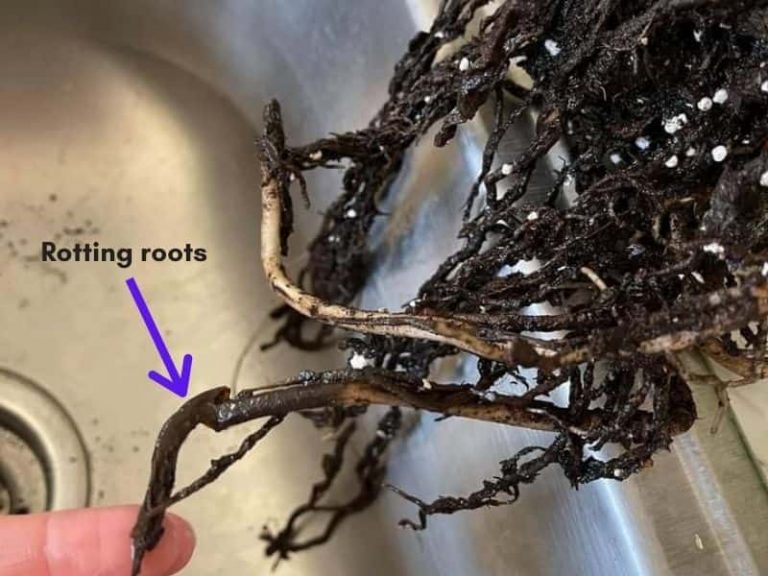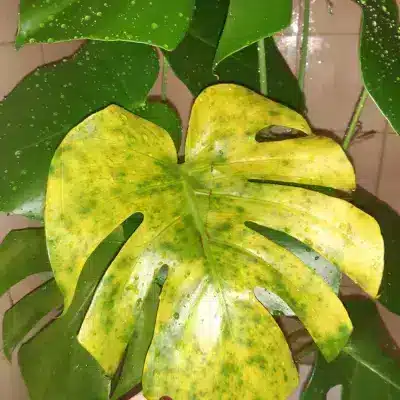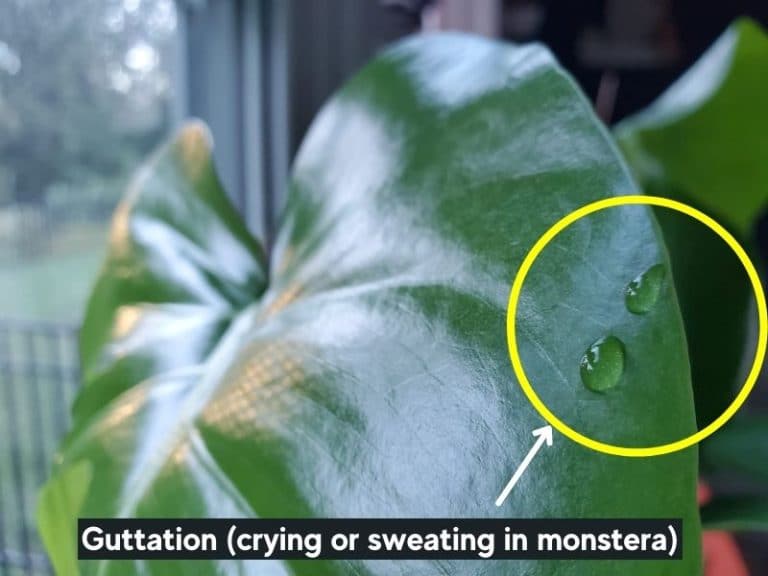Monstera Leaves Turning Black (Dark Spots) – Causes + Fixes
Monstera leaves typically show various signs of distress when the plant is experiencing unfavorable growing conditions. One of these signs is the foliage turning black. Dark spots on monstera are primarily caused by overwatering and unfavorable sunlight, humidity, and temperature conditions.
You can revive your Swiss cheese plant after diagnosing the underlying cause. Effective treatments for darkening monstera leaves include modifying the irrigation schedule and ensuring optimal environmental conditions.
Why are monstera leaves turning black?
The most common cause of black spots on monstera leaves is root rot caused by overwatering. However, other factors such as low temperatures, low humidity, pest infestation, and fungal/bacterial infection are also known to cause black marks on monstera foliage. Less common causes include underwatering, sunburn, and physical damage.
Overwatering
Monstera plants that are irrigated way too often are likely to end up with black spots on the leaves. As the soil becomes waterlogged, the roots choke out due to oxygen deficiency and die. With the monstera now unable to take in enough nutrients and water via the rotten roots, the leaves start showing signs of plant stress, brown patches being one of those signs.
The dark patches usually vary in size and may be located at the margins or center of the leaves. Monstera black patches caused by root rot/overwatering are typically accompanied by other signs like yellow leaves, droopy leaves, and smelly/soggy roots.
Low Temperatures
Monstera plants are native to the tropics and are, therefore, have a low tolerance for cold weather conditions. As the plant freezes out, the leaves start to spot black or brown marks. Monstera plants that are kept in unheated conservatories or outdoors during winter are more likely to undergo cold damage.
Low Humidity
Tropical plants like monstera love humid climates. Thus, if the relative humidity in the surrounding environment falls below 40%, your monstera is likely to develop black patches on the edges of the leaves. Black leaf edges on monstera caused by air that’s too dry usually have a distinctive, crispy appearance.
Pest Infestation
Pests like thrips and spider mites can also wreak havoc on your Swiss cheese plant and cause the leaves to develop black spots. These pests usually have sharp mouthparts that they use to pierce through the foliage and suck the plant sap. This results in tiny black or brown spots that ruin the ornamental appeal of your shiny, large monstera leaves.
Fungal/Bacterial Infection
Fungal leaf spot and bacterial leaf spot are two diseases that commonly affect monstera plants. Soil-borne fungi and bacteria thrive in wet and warm conditions. They are, therefore, likely to attack your plant if you overwater your monstera during summer.
These pathogenic infections manifest themselves as black spots on the Swiss cheese foliage. The black spots are usually equal-sized, and may also appear water-soaked with a yellow halo surrounding them.
Sunburn
In their natural habitats, monstera plants receive bright, but indirect sunlight. Thus, if you expose yours to direct sunlight, the leaves will be scorched and they’ll develop black marks. You can tell that dark marks on indoor monstera have been caused by sunburn if only the leaves facing the window are affected.
Note: For monstera growing outdoors, the black spots will be more evenly spread out on the foliage.
Mechanical Damage
When a monstera leaf undergoes physical damage such as rips or tears, the tissue around the damaged section dies and that part of the leaf turns black. Mechanical damage is more likely to occur when you touch new growth as the monstera unfurls.
Dehydration
Dehydration, caused by underwatering, may also cause brown or black spots on the edges and tips of your monstera leaves. Dehydration may also be caused by soil that dries too quickly and doesn’t hold water for long. If your monstera is root bound, the soil is likely to dry out faster.
How do you fix black monstera leaves?
You can fix black marks on monstera leaves by repotting the plant, controlling the humidity, temperature, and sunlight exposure. Adopting a balanced watering schedule and implementing pest and pathogen control measures are also effective in controlling leaf darkening in monstera.
Adopt a Balanced Watering Schedule
A balanced watering schedule will help you fix monstera dark spots caused by overwatering. Monstera plants need more water during the growing season from spring-summer, plus the soil also dries up faster during these warmer seasons. As such you should water your plant more frequently during this time of the year (at least twice a week).
Meanwhile, you should cut back on your irrigation frequency from late fall-winter (once a week). At this time of the year, the plant isn’t producing new growth and thus needs less water. What’s more, the soil dries up much slower during these cold seasons.
If you’re unsure whether the soil is dry enough for you to water your monstera again, test the wetness levels using a moisture meter. If you can’t find one, insert your finger into the soil to test for wetness.
Repot the Monstera
If the plant is dehydrated due to soil that’s too dry, un-root the monstera before repotting it in a larger container. As such, the roots will be freer and can grow longer and hold more water. When repotting monstera, also check for root rot and prune off any rotten roots.
Increase Humidity Levels
If you live in an arid or semi-arid area where monstera leaves are likely to develop black marks due to low humidity levels, install a humidifier in the room to raise humidity levels. The optimal humidity level for growing monstera plants is about 60%.
Alternatively, you can place a container filled with water next to the Swiss cheese plant. As the water evaporates into the surrounding air, the relative humidity increases, enabling the unaffected leaves to remain healthy and devoid of black spots.
Increase Temperature Levels
For leaf blackening caused by extremely low temperatures (below 10-degrees Fahrenheit), consider installing space heaters inside your indoor gardenscape. As for monstera plants growing in greenhouses, simply set the temperature levels at 60-80 degrees Fahrenheit.
During the cold season, avoid placing your Swiss cheese next to windows that leak in cold air drafts. Finally, for outdoor monstera plants, relocate them indoors during cold, winter weather.
Provide Adequate Shade
If the black spots on your monstera leaves are due to sunburn, provide adequate shade for the plant. That may entail installing window treatments to filter the sun’s rays or surrounding outdoor plants with taller trees or shrubs. You can also relocate outdoors monstera to the space underneath your porch for shade.
Placing your indoor grow lights further away from your indoor monstera also helps. Ultimately, the goal is to replicate monstera growth conditions in their natural habitats, where they receive bright, indirect sunlight.
Undertake Pest Control
You can put a stop to monstera leaf darkening caused by thrip or spider mite infestation by implementing various pest control strategies. These include dislodging the pests using jets of water, spraying the plant with organic pesticides, and introducing natural predators.
- Wash the Pests off the Monstera Leaves
A strong jet of water will easily dislodge spider mites and thrips from Swiss cheese foliage. Just ensure to seclude your monstera first if it’s kept next to other plants that aren’t yet infested, as these pesky pests may fall onto these unaffected plants.
- Spray/Wipe the Monstera Leaves with a Natural Insecticide
Organic pesticides usually eliminate monstera pests without posing any significant threats to plants, humans, animals, or the environment. Good examples include rubbing alcohol solution, horticultural oil, neem oil, and dish soap solution (detergent free).
- Introduce Natural Predators (Biological Control)
Some species of ladybugs, wasps, and lacewings feed on thrips and spider mites. You can purchase these beneficial insects from your local nursery and release them inside your garden or yard. Alternatively, you may grow flowering plants to attract these nectar-loving predators to your garden.
Undertake Pathogen Control
To effectively control dark marks on Swiss cheese caused by pathogen infestations, spray the plant with a commercial fungicide. When using commercial products to eliminate fungal diseases, follow the manufacturer’s instructions for the best results.
Should I cut black leaves off monstera plants?
If the cause of monstera leaf darkening is fungal or pest infestation, you should prune off the affected foliage to prevent the spread of the issue to unaffected leaves. However, if the leaves are spotting black marks due to any other cause, you don’t have to prune the affected leaves as they won’t cause the spread of the problem.
Note: You should also consider pruning black leaves off your monstera plants if you feel that they’re ruining the ornamental allure of your monstera plant.
Can the black spots turn green again?
There’s no known treatment that can make Swiss cheese black marks disappear. Even though a Swiss cheese leaf that has black spots can’t turn fully green again, you can diagnose and treat/fix the underlying cause, preventing the problem from spreading to other leaves.






I just repotted my monstera, 2 new leaves are starting to unfold, and I see black marks and tiny holes on them. What are they and what should I do? I really gave it a big drink when I repotted it. The rest of the plant seems to be doing fine. Thank you.